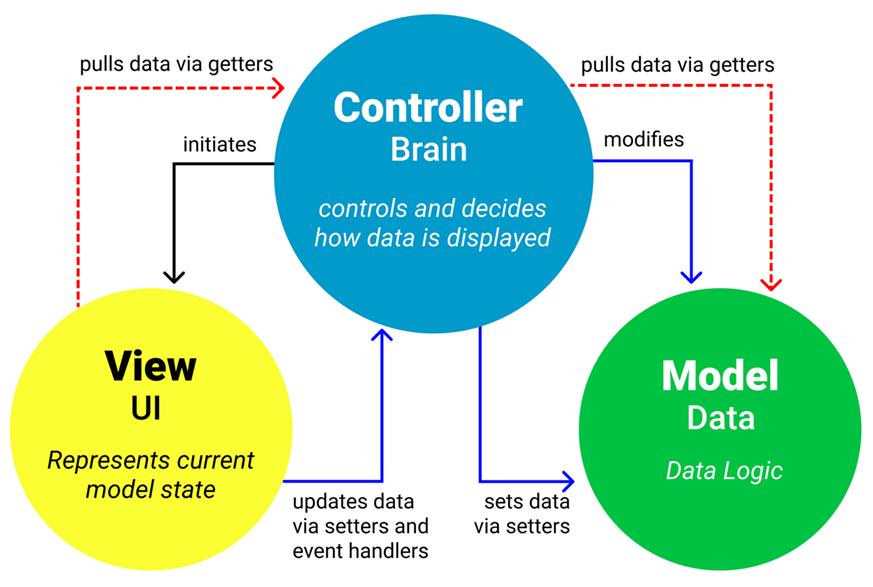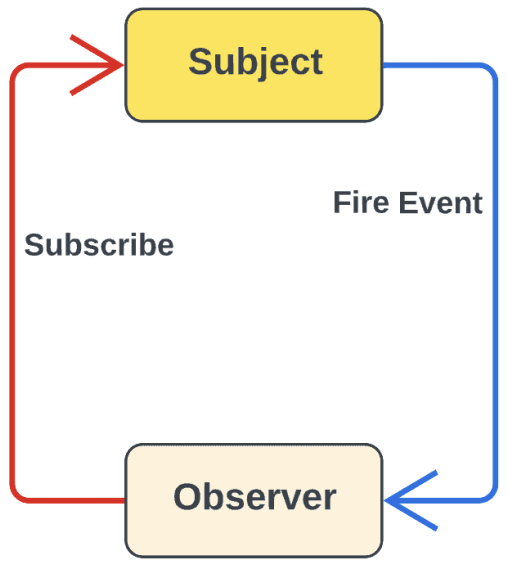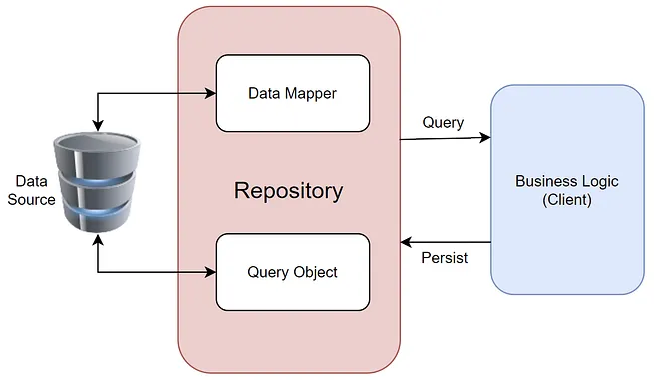Project overview
Jump to: SOLUTION -Project implementation
Skills & Concepts demonstrated
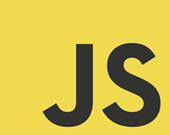
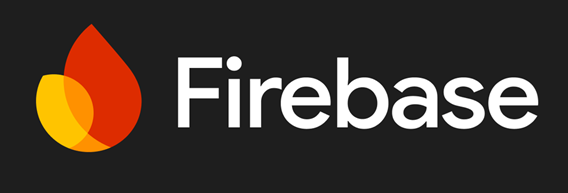 The data source is Firebase NoSQL database that triggers event for each update, delete or add action in the DB. Subscribing to event handler and providing custom callback function client has real-time data state.
The data source is Firebase NoSQL database that triggers event for each update, delete or add action in the DB. Subscribing to event handler and providing custom callback function client has real-time data state.
Problem Statement
The goal of this project is to build reusable skeleton App in MVC architecture that automatically refreshes clients upon any data change in DB.
1-How to achieve separation of business logic, application logic and presentation logic?
2-How to ensure that Model receives realtime data state from the Data source, independent who made the change?
3-How to refresh View with actual data state since the View does not know that Model as entity even exists in the App?
4-How to isolate Model from Data source-specific features and enable easier testing with mock data source?
5-How to separate the concerns of constructing objects and using them, to have loosely coupled program?
Skills & Concepts demonstrated
There are following Java Script and Software Architecture features used in this project
Insights
1. MVC architecture ensures isolation of Model (business logic) and View (presentation logic) from the Controller (application logic). Controller calls functions from Model and from the View, subscribes and listens to updating Model and updates View accordingly in the realtime. Model and View are not aware neither of each other nor of the Controller, they simply sit and wait for their functions to be called
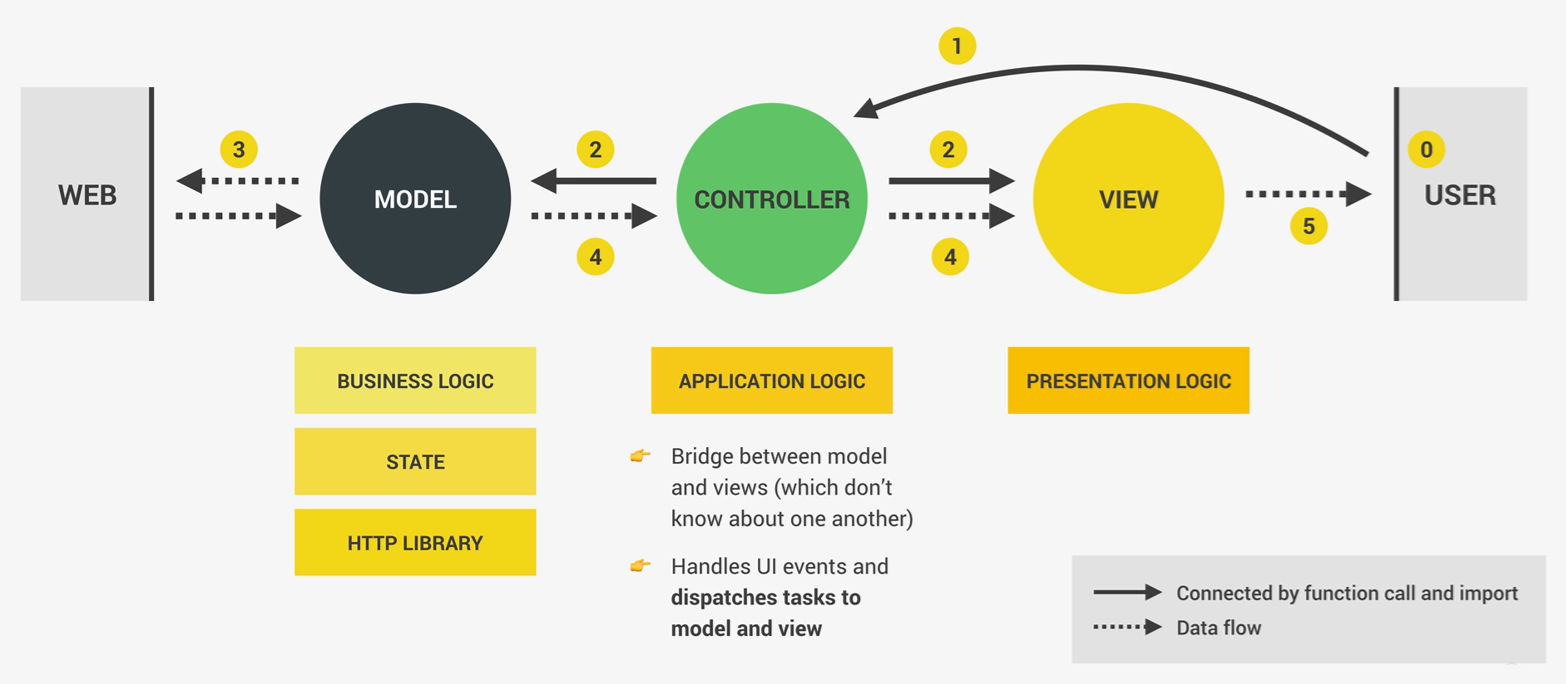
2. When data change happened in the Data Source it triggers event listener in the Observer (Model) and then the Model handles data change and updates its variables with latest values. This data change handling is being executed asynchronously within callback function that Model provided during initialization when subscribed as data change listener
3. When Model data update happened it triggers event listener in the Observer (Controller) and then the Controller performs View update with latest data state. Although showing latest data state in the View depends on Model update, View and Model are isolated from one another and cannot communicate directly, so the Observer pattern addresses this requirement
4. The DB-related logic is implemented using Repository pattern. The Model has reference to Repository class which acts as a middle layer that encapsulates database queries, keeping the Model clean and focused on domain logic. Repository class has reference to IDatabase and follows contract defined in it calling its methods. Actual DB handling is implemented in FirestoreDatabase class that extends IDatabase and implements methods that will be called on runtime
Project implementation
Back to: RESUME -Project overview
1 - MVC Application architecture
2 - Model update on data change
3 - View update on Model update
4 - Repository design pattern for proper data persistence handling
5 - Complete project implementation
All files this project contains are available on
GitHub Repo as 1-MVC-Observer-Repo.zip
1 - MVC Application architecture
MVC (Model-View-Controller) is an architectural pattern with primary role to define the architecture of an application by separating concerns—model (data), view (UI), and controller (logic).
Application entry point is app.js where Controller instance is created. Previously created Model and View are passed to Controller constructor.
// app.js
import Model from './model.js';
import View from './view.js';
import Controller from './controller.js';
// Create instances of Model and View
const model = new Model();
const view = new View();
// Inject the instances into Controller
const controller = new Controller(model, view);Controller constructor saves passed Model and View instances and calls init() method on each of them
// controller.js
import Model from "./model.js";
import View from "./view.js";
class Controller {
constructor(model, view) {
this.model = model;
this.view = view;
// Initialize the app
this.model.init();
this.view.init();2 - Model update on data change
On initialization Model is subscribed to list for listening changes in the DB, calling subscribeCollection function from dbFirestoreNoSQL module, providing it's method handleChanges as callback function
// model.js
class Model {
init() {
// Subscribe to the Firestore collection 'Dummy' and listen for changes
subscribeCollection("Dummy", this.handleChanges.bind(this)); // Pass as callback function
}
// Function to handle changes from Firestore and update the Model's data
handleChanges(newValue) {
this.data = extractvalues(newValue); // Update the model's data with the new value
}Database handling module - Key points
1-Function subscribeCollection receives collection and callbackFunction as parameters
2-It calls onSnapshot function that returns function to be called in order to unsubscribe
3-Function onSnapshot is called with 2 arguments: the 1st is Firestore collection reference and the 2nd is callback function querySnapshot that runs on data change
4-Within querySnapshot function is called callbackFunction passed from Model
// dbFirestoreNoSQL.js
export function subscribeCollection(collectionName, callbackFunction) {
if (unsubscribe) // initially null
unsubscribe(); // Stops listening to the previous item
collectionListening = collection(db, collectionName);
// onSnapshot returns a function that can be called to unsubscribe from updates
unsubscribe = onSnapshot(
collectionListening, // the 1st argument: Firestore collection reference to listen to
(querySnapshot) => // the 2nd argument: callback function that runs on data change
{ // querySnapshot callback function begins
const docsToUpdate = [];
querySnapshot.forEach((docSnap) => { // calling Firestore's forEach method on QuerySnapshot object
docsToUpdate.push({ [docSnap.id]: docSnap.data() }); // extracting document data
});
callbackFunction(docsToUpdate); // calling Model's callback function with updated data
} // querySnapshot callback function ends
); // onSnapshot call ends
} // subscribeCollection implementation endsRefactoring using named function instead of Arrow function
READING SEQUENCE TOP-BOTTOM
EXECUTION SEQUENCE
// dbFirestoreNoSQL.js
function handleSnapshot(querySnapshot) { //(2)
const docsToUpdate = [];
querySnapshot.forEach(function(docSnap) {
docsToUpdate.push({ [docSnap.id]: docSnap.data() });
});
callbackFunction(docsToUpdate); //(3)
}
// Now, call onSnapshot with this function
unsubscribe = onSnapshot(collectionListening, handleSnapshot); // (1)
Inside subscribeCollection, callbackFunction is available to all inner functions due to closure. Since handleSnapshot is defined inside subscribeCollection, it inherits access to callbackFunction (Model's method handleChanges) . It is resolved at runtime due to closures — handleSnapshot still has access to callbackFunction, even though it's not explicitly passed in.
When onSnapshot is called for the first time (Initial Snapshot), Model is subscribed as observer to data changes in the database (Observer Pattern) and provides it's method as callback function (handleChanges):
3 - View update on Model update
After handling changes and updating it's data, Model will notify subscribed listeners about the change. Subscribed listener is Controller, that in ctor adds itself to Model's observer list. Function renderContent for updating view, that Controller calls in ctor, is also called in function onModelUpdate
// model.js
class Model {
constructor() {
this.observers = []; // Array to hold observers
}
// Function to handle changes from Firestore and update the model's data
handleChanges(newValue) {
this.notifyObservers(); // Notify all observers about the data change
}
// Function to add an observer
addObserver(observer) {
this.observers.push(observer);
}
// Function to notify all observers that data has changed
notifyObservers() {
this.observers.forEach(observer => observer.onModelUpdated(this.data));
}// controller.js
class Controller {
constructor(model, view) {
// Register the Controller as the observer of the Model
this.model.addObserver(this); // Controller is the observer now
// Pass the model data to the View to render
this.view.renderContent(this.model.data);
}
// Function to update the view (called when Model data changes)
onModelUpdated(data) {
this.view.renderContent(data); // Pass the updated data to the View
}4 - Repository design pattern for proper data persistence handling
There are following components and their roles in Repository design pattern
// model.js
class Model {
constructor(repository) {
this.repository = repository;
}
init() {
// Subscribe to the Firestore collection 'Dummy' and listen for changes
this.repository.subscribeCollection("Dummy", this.handleChanges.bind(this));
}
// Function to fetch message from Firestore
async fetchMessage() {
const message = await this.repository.readDBkey("Dummy", "DummyDoc", "DummyMsg");
this.data = message;
}
// Function to update the data in Firestore
async updateDataToDB(value) {
await this.repository.updateDB("Dummy", "DummyDoc", "DummyMsg", value); // Update the value in DB
}
}
// app.js
import Repository from "./repository.js";
import FirestoreDatabase from "./database/FirestoreDB.js";
// Use Firestore as the database
const database = new FirestoreDatabase();
const repository = new Repository(database);
const model = new Model(repository);5 - Complete project implementation
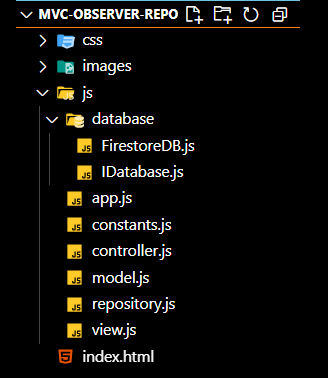 In the project root there is index.html. Javascript files are placed in js folder, style in css folder and DB handling code in database subfolder of js folder. In the <head> section of index.html the only script file referenced is app.js. It is app entry point, and it imports all other modules. Model and View are isolated from one another an import only common constants they need. All application logic ih handled by Controller that calls functions from Model and View.
In the project root there is index.html. Javascript files are placed in js folder, style in css folder and DB handling code in database subfolder of js folder. In the <head> section of index.html the only script file referenced is app.js. It is app entry point, and it imports all other modules. Model and View are isolated from one another an import only common constants they need. All application logic ih handled by Controller that calls functions from Model and View.
DB handling logic is separated using Repository pattern. All neccessary DB-specific scripts are referenced in FirestoreDB.js. In the model.js the Repository object is passed in constructor, and DB-related methods are called on that object. Repository object calls standard contract-defined methods on IDatabase, which are at runtime resolved to particular methods implemented in FirestoreDatabase class that extends IDatabase interface. In app.js object of FirestoreDatabase is created and passed to created Repository object. It is passed to created Model object which is passed to created Controller object.
There are all project files:
<!-- index.html -->
<!DOCTYPE html>
<html lang="en">
<head>
<meta charset="UTF-8">
<meta name="viewport" content="width=device-width, initial-scale=1.0">
<title>MVC-Observer-Repository </title>
<link rel="stylesheet" href="css/style.css">
<!-- Add Firebase CDN (This includes both Firebase App and Firestore) -->
<script type="module" src="./js/app.js"></script>
</head>
<body>
<div class = "maindiv">
<div class="centraldiv">
<input class = "uicontrols" id = "inputContent"></input> <br />
<button class = "uicontrols button" id="btnWrite">Write to DB</button>
<button class = "uicontrols button" id="btnRead">Read from DB</button> <br /><br />
<label id="output" class = "uicontrols label">Write to DB or Read from DB</label><br />
<img src = "images/mysql.png" height="50"/>
<img src = "images/cassandra.png" height="50"/>
<img src = "images/dynamodb.png" height="50"/>
<img src = "images/hbase.png" height="50"/>
<img src = "images/redisdb.png" height="50"/>
<img src = "images/firebase.png" height="50"/>
<img src = "images/mongodb.png" height="50"/>
<img src = "images/postgresql.png" height="50"/>
<img src = "images/neo4j.png" height="50"/>
<img src = "images/neptune.png" height="50"/>
</div>
</div>
</body>
</html>/* style.css */
.uicontrols {
height: 50px;
width: 404px;
font-size: 24px;
padding: 5px; /* Ensures padding doesn’t add extra height */
border: 1px solid #ccc; /* Ensures consistency */
border-radius: 8px;
box-sizing: border-box; /* Ensures height includes border & padding */
vertical-align: middle; /* Aligns them properly */
}
.button {
width: 200px;
margin-top: 5px;
}
.label {
height: 40px;
margin-top: 5px;
border-style: none;
color: #444;
display:block;
}
.centraldiv {
position: absolute;
top: 50%;
left: 50%;
transform: translate(-50%, -50%);
}
.maindiv {
position: absolute;
top: 50%;
left: 50%;
transform: translate(-50%, -50%);
height: 500px;
width: 800px;
background-color: #DDF;
border: 2px solid #888; /* Ensures consistency */
border-radius: 18px;
}// app.js
import Model from './model.js';
import View from './view.js';
import Controller from './controller.js';
import Repository from "./repository.js";
import FirestoreDatabase from "./database/FirestoreDB.js";
// Use Firestore as the database
const database = new FirestoreDatabase();
const repository = new Repository(database);
const model = new Model(repository);
const view = new View();
// Inject the instances into Controller
const controller = new Controller(model, view); // App entry point// model.js
import { GAME_LEVELS } from "./constants.js";
class Model {
constructor(repository) {
this.data = ""; // Placeholder for storing data
this.gameLevels = GAME_LEVELS;
this.repository = repository;
this.observers = []; // Array to hold observers (the Controller)
}
// Init function to set initial data to "Welcome!"
init() {
this.data = "Welcome back!"; // Initialize the data with "Welcome!"
// Subscribe to the Firestore collection 'Dummy' and listen for changes
this.repository.subscribeCollection("Dummy", this.handleChanges.bind(this)); // Pass handleChanges as the callback f.
}
// Function to handle changes from Firestore and update the model's data
handleChanges(newValue) {
const doc = newValue.find(el=>el.hasOwnProperty('DummyDoc'));
this.data = doc['DummyDoc'].DummyMsg; // Update the model's data with the new value
console.log("DB:", this.data); // Log the updated value to the console
this.notifyObservers(); // Notify all observers (controller) about the data change
}
// Function to add an observer (Controller)
addObserver(observer) {
this.observers.push(observer);
}
// Function to notify all observers that data has changed
notifyObservers() {
this.observers.forEach(observer => observer.onModelUpdated(this.data));
}
// Function to fetch message from Firestore
async fetchMessage() {
const message = await this.repository.readDBkey("Dummy", "DummyDoc", "DummyMsg");
this.data = message;
}
// Function to update the data in Firestore
async updateDataToDB(value) {
await this.repository.updateDB("Dummy", "DummyDoc", "DummyMsg", value); // Update the value in DB
}
}
export default Model;// view.js
import { GAME_LEVELS } from "./constants.js";
class View {
constructor() {
this.gameLevels = GAME_LEVELS;
this.inputElement = document.getElementById("inputContent"); // Reference to input element
}
// Function to update the input element with the message
renderContent(message) {
this.inputElement.value = message;
}
// Init function to set the initial content of inputContent
init() {
this.inputElement.value = "";
}
}
export default View;// controller.js
class Controller {
constructor(model, view) {
this.model = model;
this.view = view;
// Initialize the app (sets initial content in inputContent)
this.model.init();
this.view.init();
// Register the controller as the observer of the model
this.model.addObserver(this); // Controller is the observer now
// Pass the model data to the view to render
this.view.renderContent(this.model.data);
// Bind buttons to click event
document.getElementById("btnRead").addEventListener("click", this.handleReadClick.bind(this));
document.getElementById("btnWrite").addEventListener("click", this.handleWriteClick.bind(this));
}
// Handle the click event for the Read button
async handleReadClick() {
await this.model.fetchMessage(); // Fetch message from Firestore
this.view.renderContent(this.model.data); // Update the view with the message
}
// Handle the click event for the Write button
async handleWriteClick() {
const valueToWrite = document.getElementById("inputContent").value; // Get the current value
await this.model.updateDataToDB(valueToWrite); // Update the value in Firestore
}
// Function to update the view (called when model data changes)
onModelUpdated(message) {
this.view.renderContent(message); // Pass the updated message to the view
}
}
export default Controller; // constants.js
export const GAME_LEVELS = 6;// repository.js
class Repository {
constructor(database) {
this.database = database; // Injected FirestoreDatabase
}
async readDBkey(coll, doc, key) {
return this.database.read(coll, doc, key);
}
async updateDB(coll, doc, key, value) {
return this.database.update(coll, doc, key, value);
}
subscribeCollection(coll, callback) {
this.database.subscribeCollection(coll, callback);
}
}
export default Repository;// database/IDatabase.js
class IDatabase {
async read(coll, doc, key) {
throw new Error("read() must be implemented");
}
async update(coll, doc, key, value) {
throw new Error("update() must be implemented");
}
subscribeCollection(coll, callback) {
throw new Error("subscribeCollection() must be implemented");
}
}
export default IDatabase;// database/FirestoreDatabase.js
import IDatabase from "./IDatabase.js";
import { initializeApp } from "https://www.gstatic.com/firebasejs/10.11.1/firebase-app.js";
import { getFirestore, collection, getDoc, updateDoc, onSnapshot, doc }
from "https://www.gstatic.com/firebasejs/10.11.1/firebase-firestore.js";
// Firebase config
const firebaseConfig = {
apiKey: "AIzaSyCBSwWx50dibvQQcGd2-ZtWiAghCi1EMI0",
authDomain: "mastermindbv75.firebaseapp.com",
projectId: "mastermindbv75",
storageBucket: "mastermindbv75.firebasestorage.app",
messagingSenderId: "245901977986",
appId: "1:245901977986:web:d7716512d026ff10fc479b"
};
class FirestoreDatabase extends IDatabase {
constructor() {
super();
// Initialize Firebase inside the class
this.app = initializeApp(firebaseConfig);
this.db = getFirestore(this.app); // Firestore instance
this.unsubscribe = null; // Store unsubscribe function
}
async read(coll, docId, key) {
const docRef = doc(this.db, coll, docId);
const snapshot = await getDoc(docRef);
return snapshot.exists() ? snapshot.data()[key] : null;
}
async update(coll, docId, key, value) {
const docRef = doc(this.db, coll, docId);
await updateDoc(docRef, { [key]: value });
return { key, value };
}
subscribeCollection(coll, callback) {
// First, unsubscribe from the previous listener (if any)
if (this.unsubscribe)
this.unsubscribe();
const collectionRef = collection(this.db, coll);
this.unsubscribe = onSnapshot(collectionRef, (querySnapshot) => {
const docsToUpdate = [];
querySnapshot.forEach((docSnap) => {
docsToUpdate.push({ [docSnap.id]: docSnap.data() });
});
callback(docsToUpdate);
});
}
}
export default FirestoreDatabase;